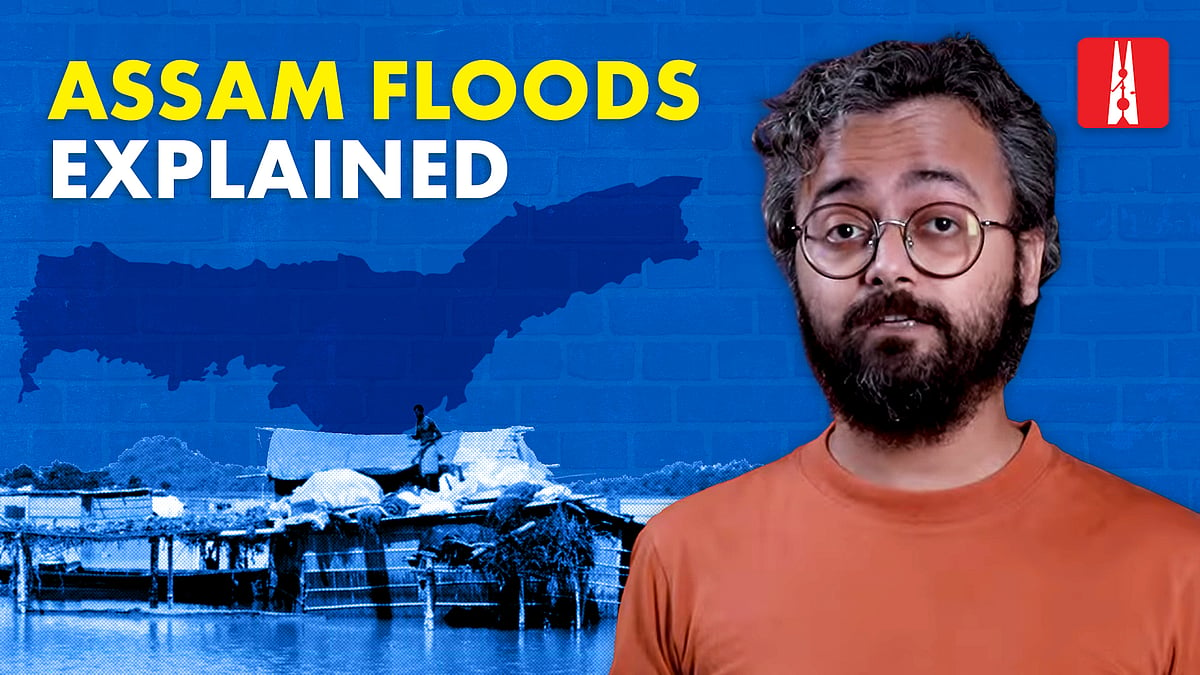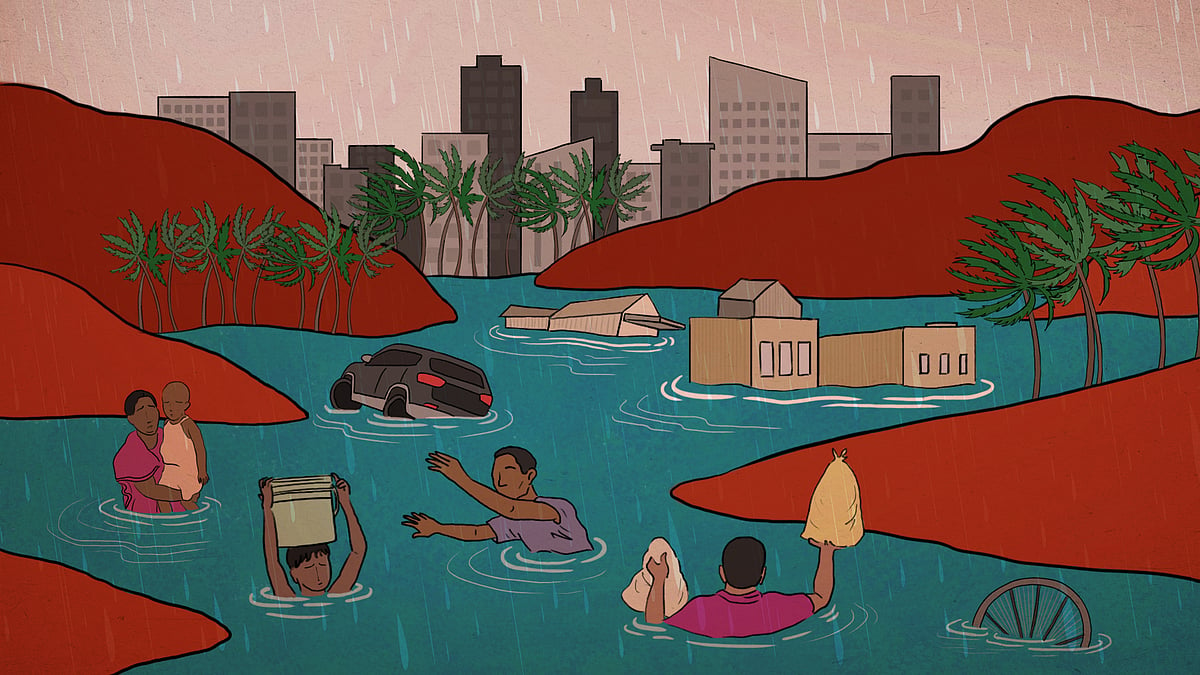For media, some floods matter more than others
These floods can’t simply be called ‘natural disasters’. Media must address climate change, politics of water and land.
In this season of floods, some floods matter more than others. You can see this in the amount of time and space the media accords to some floods, while virtually ignoring others.
Then we have the entrenched politics of water and land, as well as factors that transcend state and national boundaries such as climate change. We in the media should be addressing these politics and the reality of climate change, while covering the current spate of floods in the region which cannot be categorised simply as “natural disasters”.
The floods that matter, and which we report in detail, are those in the big cities. This entails minimum costs for media houses as the crisis is literally on their doorsteps. Those affected are also part of the “market” of these media houses. Floods further afield, in the northeast for instance, do not engage mainstream media in India to this extent.
The coverage of the recent flooding of large parts of Bengaluru, which undoubtedly was big news given the city’s global connections, exposed another aspect of the coverage of floods. While the visuals of upscale villas in gated communities and floating high-end automobiles might make for dramatic footage, we saw little of the devastation caused to the urban poor parked just outside the gates of these colonies.
Also, you had to look hard to find reportage explaining the backstory of why Bengaluru is in such a mess. In fact, such a disaster has been predicted for long by environmentalists and urban planners. They have exposed and campaigned against the destruction of natural lakes around the city, the construction on lake beds and misplaced urban development plans that cater to the demands of private developers. This, and an inadequate drainage system, has had a direct impact on Bengaluru’s ability to cope with excessive rainfall.
The Bengaluru flooding story has been seen in practically every major metro in India, and even in smaller cities and towns. This is decidedly not a “natural” disaster. It is the consequence of how the politics of land, inextricably linked to city and state politics, plays out. Urban development plans are made, only to be ignored. And environmental concerns go unheeded despite the campaigning of determined civil society groups. Practically no political party makes these concerns a part of its agenda. Profits, not prudence, is the mantra all of them follow.
For the media, these recent floods in Bengaluru underline not only the abysmal lack of planning and development in that city, but the gap in the media’s understanding of the larger issues behind this disaster.
For one, understanding the consequences of land use, and the politics behind it, as well as how natural resources such as water are used, or abused, needs to be the foundation for city reporting. Journalists given this beat must understand this politics to be able to report incisively not just on events, like floods, but also on why they occur.
Second, reporters need to understand that the worse-affected in these “unnatural” disasters are those with the least clout in how decisions are made in city development. So, in Bengaluru too, several urban poor communities lost everything they possessed in the floods. Once the waters recede, and there is talk of compensation, the well-heeled will recover from insurance claims. The poor will be left with nothing, especially as in many instances they either do not possess, or have lost, the documentation to establish that they are “legal”.
As urban planner and civil engineer Vishwanath S explains in this interview to Scroll:
“There are a lot of informal areas around the Information Technology hub that have been affected. These areas are not being documented or being shown. They may or may not be legal slums, which is more concerning as that means there is a good chance they would not even have the inadequate drainage systems in place. Then there is the periphery of the state which is being affected, which is not being documented and shown either. The focus has been on the apartments worth Rs 9 crore or Rs 13 crore or the villas which have been flooded.”
Equally important, journalists reporting on cities must comprehend how climate change is affecting our cities in a very direct way, not just by way of extreme weather events. It will help reporters dig deeper to understand the backstory, so that readers or viewers develop a better understanding of why such disasters are occurring so frequently.
Moving on from Bengaluru, the much bigger crisis is what has occurred in what we love to refer to as our “neighbouring country”, that is Pakistan. The scale of the devastation is hard to imagine. The visuals seen on international TV channels, and on social media, are frightening. Just visualising one third of a country under water is tough. Yet that is the reality in Pakistan today.
Although there has been some coverage of the devastation next door in the Indian media, it is not enough. The reason it needs to be much more detailed is obvious. India has not just a shared history with Pakistan, but also a shared geography. As the current director of Pakistan’s Human Rights Commission, Farah Zia points out in this perceptive article in Indian Express: “We’re in it together. ‘We’, as in India and Pakistan. Our weather systems like our history are joined at the hip.”
What is also interesting is how, as in India, in Pakistan too, the media ignored the early warning signs of the floods, because they occurred as early as July in Balochistan which, as Farah Zia writes,“… is not on the media’s radar anyway. It only got attention when an army helicopter on a flood relief and rescue mission, with high-profile personnel on board, crashed on August 2. The province also got the media’s attention once the death toll crossed 100.”
Historian Ammar Ali makes a similar point when he writes in this article in Jacobin that Islamabad-based political commentators were preoccupied writing about politics even as the first information about the devastation was coming through on social media. “Soon, floods began overwhelming areas in Sindh and south Punjab. The first time floods became the main headline on a Pakistani channel was August 23. By this time, more than twenty million people had already been affected, making it the worst natural disaster in the country’s recent history,” he writes.
Maleeha Lodhi, a former journalist who was also a top diplomat, reiterates that while politicians were more concerned about their political agendas, it is Pakistani civil society that stepped in to help. “The exemplary role of the public should be matched by a display of solidarity among political leaders and parties. But this continues to be in short supply”, she writes in this article that first appeared in Dawn.
Ali makes another observation that I think is relevant for us in the media in India.
“The media’s delayed response to the climate catastrophe is partly explained by the fact that the narrative around ‘natural disasters’ does not easily offer a neat categorization of heroes and villains. This turns them into a tragedy that can invoke global pity but is unable to generate political contestation. Yet, politics really is at the heart of the tragedy today unfolding in Pakistan. It is thus imperative to nominate the villains responsible for the needless suffering of millions of people.”
If you noticed, the political blame game has already begun in Bengaluru. It happens all the time when such disasters take place. Yet the real “villains”, which would include all political parties and those who benefit from political power, and the way both flout long-term plans for short-term gains, are rarely identified. That is the role that only an independent media can play, an increasingly endangered species in both India and Pakistan.
 Explained: Why does Assam flood every year and what’s the state doing about it?
Explained: Why does Assam flood every year and what’s the state doing about it? Neglect, apathy, and a destructive train route: Why Maharashtra's villages flood every year
Neglect, apathy, and a destructive train route: Why Maharashtra's villages flood every year